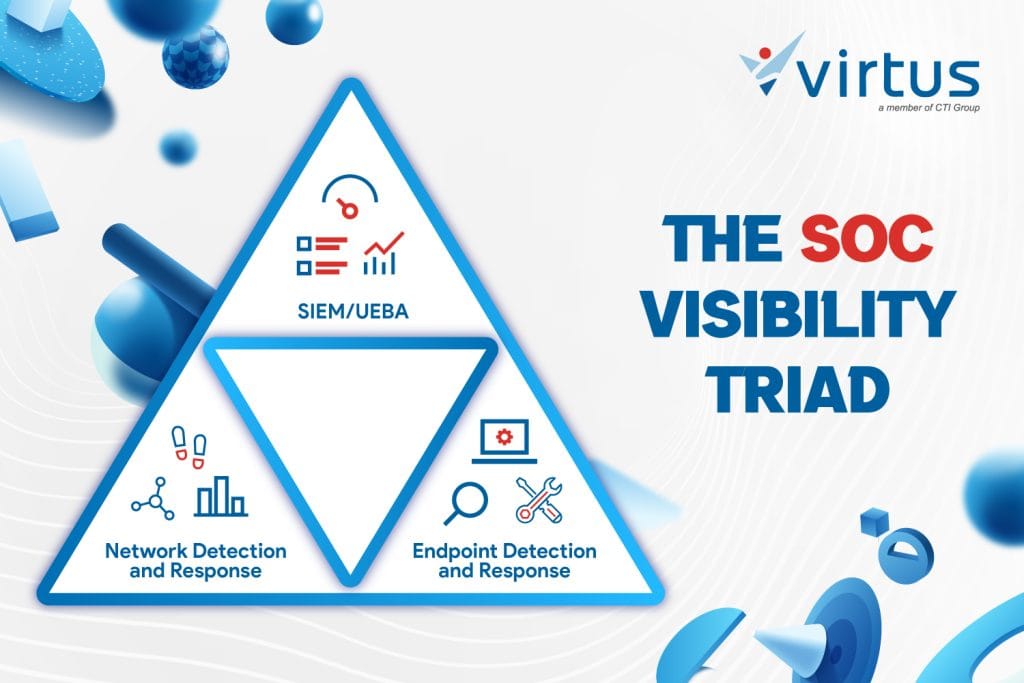The landscape of modern cybersecurity is becoming increasingly complex and dynamic, compelling organizations to continuously adapt to emerging threats. While many companies still rely heavily on prevention-focused strategies to safeguard their infrastructure, this approach alone is no longer sufficient. As the volume and sophistication of cyber-attacks continue to rise, it is imperative for organizations to not only prevent breaches but also be prepared to detect and respond to security incidents quickly and effectively.
One comprehensive approach that is gaining popularity is the SOC Visibility Triad. This concept integrates three core pillars of security management: Network Detection and Response (NDR), Endpoint Detection and Response (EDR), and Security Information and Event Management (SIEM). With this combination, security teams gain complete visibility into all network and endpoint activities, enabling them to detect and respond to threats more efficiently.
In this article, we will delve deeper into what the SOC Visibility Triad is, why this approach is crucial in combating modern cyber threats, and the various benefits organizations can achieve by adopting this strategy.
What is the SOC Visibility Triad?

The SOC Visibility Triad is a cybersecurity framework with three main components designed to enhance visibility and threat detection capabilities within a Security Operations Center (SOC). The concept was first introduced by the research firm Gartner and aims to provide comprehensive insights into network activities, endpoints, and data movement throughout the entire IT infrastructure.
By integrating these three components, the SOC Visibility Triad helps security teams detect and respond to cyber threats more effectively while reducing blind spots that attackers often exploit.
The Three Pillars of the SOC Visibility Triad
Here are the three main components of the SOC Visibility Triad:

1. Network Detection and Response (NDR)
NDR focuses on monitoring and analyzing network traffic in real-time to detect suspicious or unusual activities. By leveraging methods such as network behavior analysis and mMachine lLearning, NDR can identify threats like Distributed Denial of Service (DDoS) attacks, malware communicating with Command and Control (C&C) servers, and lateral movement activities that traditional firewalls or other security solutions might not detect.
2. Endpoint Detection and Response (EDR)
EDR focuses on monitoring and analyzing activity on endpoint devices, such as computers, servers, and mobile devices, to detect potential threats. EDR collects data from these devices, including running processes, accessed files, and configuration changes, which is then automatically analyzed. If indications of an attack are found, such as malware-infected files or suspicious user behavior, EDR can alert the security team for further investigation.
3. Security Information and Event Management (SIEM)
SIEM is a system that collects, analyzes, and manages logs from various sources across the IT infrastructure, such as network devices, servers, applications, and security solutions. SIEM provides comprehensive visibility into network and system activities and enables security teams to correlate events and identify attack patterns. SIEM is also commonly used for compliance purposes (e.g., GDPR and CCPA) as it provides a complete audit trail.
Read More: Implementing Application Security to Protect Critical Company Data
Challenges in Implementing the SOC Visibility Triad
Implementing the SOC Visibility Triad is not without its challenges. Here are some of the main obstacles that need to be addressed for this strategy to be successful:
Complex IT Infrastructure
The more complex an organization’s IT infrastructure, the harder it is to achieve comprehensive visibility. The use of disparate security solutions (EDR, NDR, SIEM) from various vendors can result in system incompatibilities and data silos, potentially creating blind spots.
Resource Constraints
Not all organizations have sufficient human and financial resources to support the implementation of the SOC Visibility Triad. Security teams are often stretched thin, while the demand for threat monitoring and analysis continues to grow.
False Positives and Noise
One of the biggest challenges is managing the high volume of alerts, especially from SIEM systems. Without proper filtering and analysis, false positives can overwhelm the security team, making it difficult to prioritize real threats.
Complex Data Integration
Integrating data from various security tools can be challenging. Data from EDR, NDR, and SIEM needs to be properly correlated to provide accurate threat context. This requires strong data integration capabilities and advanced analytics.
Dynamic Threat Evolution
The evolving nature of attack methods and tactics used by adversaries requires organizations to continually evaluate and update their security strategies to stay relevant.
Why is the Security Operations Center (SOC) or SOC Visibility Triad Important for Businesses?
The SOC Visibility Triad plays a critical role in building a stronger and more responsive cybersecurity defense. The increasing volume and sophistication of cyber threats make traditional security strategies less effective. By integrating NDR, EDR, and SIEM, the SOC Visibility Triad provides the comprehensive visibility needed to detect, analyze, and respond to threats proactively.
Additionally, the SOC Visibility Triad helps reduce the risk of blind spots often exploited by attackers and provides the contextual information needed for deeper investigations. It also enables faster threat detection, allowing security teams to respond to incidents more efficiently and minimize the impact on business operations.
Benefits of Implementing the SOC Visibility Triad

Adopting the SOC Visibility Triad provides many benefits for an organization’s security posture, including:
Improved Threat Detection
With enhanced visibility across the network, endpoint, and logs, the SOC Visibility Triad enables more comprehensive and accurate threat detection.
More Efficient Threat Response
Integrating the three components (NDR, EDR, SIEM) accelerates the identification and response to security incidents, reducing dwell time and minimizing potential damage.
Reduced Security Complexity
Instead of using disparate tools that operate in silos, the SOC Visibility Triad allows the unification of security solutions, resulting in more integrated analytics and insights.
Regulatory Compliance
The SOC Visibility Triad helps organizations maintain compliance with industry regulations and legal requirements, such as GDPR or PCI-DSS, by providing the visibility needed to track and document all activities.
Enhanced Operational Efficiency
Comprehensive visibility and centralized analytics enable automation in monitoring and reporting, ultimately reducing the workload of the security team and allowing them to focus on significant threats.
Next Steps to Implement the SOC Visibility Triad
Implementing the SOC Visibility Triad is a proactive and strategic step to strengthen an organization’s cybersecurity posture. By combining the three core components—Network Detection and Response (NDR), Endpoint Detection and Response (EDR), and Security Information and Event Management (SIEM)—organizations can achieve more comprehensive visibility into network activity, endpoint devices, and security logs.
The next step is for organizations to ensure that these three components are seamlessly integrated. Effective integration involves adopting a holistic security architecture, aligning with existing security policies, and establishing access controls based on data sensitivity.
Leveraging automation and artificial intelligence/machine learning (AI/ML) technology can further help reduce noise (false positives) in threat detection, facilitate more efficient monitoring, and enhance the speed of incident response.
To optimize the SOC Visibility Triad strategy, it is essential for organizations to build a well-trained and experienced security team. Recruitment, training, and development processes should focus on enhancing threat analysis capabilities, understanding advanced security technologies, and responding to complex incidents effectively. This approach will enable organizations to establish a robust, responsive Security Operations Center (SOC) prepared to tackle cybersecurity.
Virtus Offers Integrated SOC Solutions
Virtus provides reliable solutions to support the effective implementation of a Security Operations Center (SOC) with 24/7 security monitoring capabilities and fast and accurate threat detection.
Virtus delivers a suite of technologies such as Network Detection and Response (NDR), Extended Detection and Response (XDR), Security Information and Event Management (SIEM), Vulnerability Assessment (VA), and Governance, Risk, and Compliance (GRC). These technologies support companies in combating cyber threats across cloud or hybrid environments, providing full visibility across all layers of security, detecting threats in real-time, and helping security teams respond to incidents quickly and efficiently.
In addition, Virtus’ solutions enable automatic monitoring, AI/ML-based data analysis, and centralized security policy management, allowing organizations to reduce the complexity of security management and maximize the protection of their digital assets. With Virtus, companies can enhance the effectiveness of their SOC, strengthen cyber resilience, and ensure compliance with applicable regulations.
Get the SOC Visibility Triad with Virtus
Interested in learning more about Virtus’s SOC solutions? Contact us now and get customized security consultations and solutions tailored to your business needs. Don’t let cyber threats disrupt your operations—build a strong SOC strategy with Virtus and safeguard your IT infrastructure against evolving threats!
Author: Ary Adianto
Content Writer – CTI Group



























